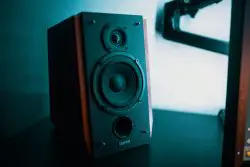Introduction
Computers are a lot more capable than they were several years ago. Now people can mix and match audio records from them, put on a DJ show, and even play high quality home theater audio. But it’s not always straightforward on how exactly to set this up. Older home theater systems are a little more complicated, with more wires and connections that you have to manage.
Newer setups even come without receiver systems and instead link audio directly through a single HDMI cord. Regardless of your set up, this article will help you understand how you can use home theater speakers with a computer as well as some additional information if you don’t yet have a speaker system. As always, feel free to reach out at entertainmentden.ns@gmail.com if you have additional questions and I’ll do my best to respond.
Table of Contents
Connecting Cables to Your Computer
Configuring Computer Settings for Speaker Output
Connecting a Soundbar
Using HDMI for audio
Connecting a Laptop to Surround Sound Systems
Connecting Cables
Step 1: Ensure that you have 3 3.mm to RCA cables.
You need to have 3 of them for your 5.1 speaker system! Your computer is going to have the 3.5mm imports in which that end connects to your computer. No matter what sound card you have on your PC, these cables will be compatible with both your speaker system and computer. Your computer will have to be within a few feet of the main speaker that has all the connector cables. If you’re using a soundbar, then connect through Bluetooth or a standard aux cord. Receivers will also have the import jacks you need as well. In the video below, you can see how to connect each of the cables to the PC and home theater system.
Step 2: Connect the cables with the corresponding jack ports.
This step is super easy and perhaps the most important going forward. Computers have certain colored audio ports such as blue, green, and pink / red. My cords look exactly like the ones in the video and yours should too.
Connect the Blue port to SR (surround right) and SL (surround left) on your home theater receiver
Connect the Green port to FR (front right) and FL (front left) on your home theater receiver.
Connect the Pink port on your PC to the C (center) and SW (Sub-Woofer) part on your home theater receiver.
If you don’t have a sub woofer or one of the speaker sets mentioned above, then omit those steps. You can always add speaker systems to create a complete 5.1 system in the future.
Configuration
In traditional 5.1 audio systems, you will need to download or utilize an Audio Manager application on your computer.
The best application you can use to manage all sound output and settings is Realtek HD Audio Manager in Windows 10. Newer computers will already have the latest version of this software installed but here’s how to confirm if you have the most updated and correct version for speaker calibration.
Test Your Audio Output
If your speakers immediately calibrate and output the correct audio for each one, then you’re set! If not, then some quick and easy audio calibration is needed to complete your set up.
Go to your audio device settings and see if you can “configure speakers” by default.
Utilize your Realtek HD Audio application and pair the three audio port settings from the cords you just plugged in.
If you’re having issues, you might need to perform the following steps:
Uninstall Your Current Realtek HD Audio
Step 1: Device Manager –> Sound Video and Game Controllers –> Realtek High Definition Audio –> uninstall, delete driver software for this device .
Step 2: Device Manager –> View–> Show hidden devices (delete and uninstall any audio that has Realtek HD in case you missed it).
Step 3: Download drivers that calibrate with your speaker setup. In order to save you a bunch of hassle. I recommend calling Best Buy if you need help with this step. They’ve always helped me with my home theater set up and they even do free consultations. If you’re having trouble with this step because of your unique set up, they can give you one on one support for this so you don’t have to stress about it.
Connecting a Soundbar to Your Computer
There’s a couple ways to connect this to your computer. The easiest way would be to connect to the Soundbar using Bluetooth. These speaker systems are super responsive and latency shouldn’t be an issue if your computer has a regular Bluetooth connection.
You can also use a two-way 3.5mm jack and set the soundbar settings to Audio Out and play sound from there. You’ll have to plan on playing media from your computer, as the soundbar will act as an external speaker to your computer instead of your projector or PC.
Playing Audio With HDMI Connections
Yes, this is entirely possible! You have to adjust the settings of your computer if you want to send the audio to your speaker.
Go to Control Panel –> Sound –> Playback tab –> HDMI setting.
Note: If you’re able to utilize an HDMI cord, then it might be easier to just use an Aux connection to make things easier. When I was moving around my home theater speakers, there was a period of time where I connected my laptop video through HDMI and then an Aux cord for my speakers. Doing it this way removed the need for cord signal configuration.
Connecting a Laptop To Surround Sound Systems- HDMI and VGA
First, you need two HDMI cords.
One goes to your laptop and the other goes to the (PC) port on your home theater receiver. The second HDMI cord plugs into the port (main) on your receiver and to the video port of your TV or projector.
There is also a way to connect your laptop to a surround sound speaker system using VGA a (1) 3.5mm to RCA cable.
Verify that the VGA connection on your screen and laptop are both female.
1. Connect the VGA cord to the laptop and to the screen
2. Connect the 3.5mm end into the headphone jack of the laptop
3. Connect the RCA end of the cord into your reciver (labeled “PC”). Plug the white into the white and the red into the red. Make sure your TV or Projector source is set to PC input or the sound won’t work.
Conclusion
As you can see, there are several different ways to set up your home theater audio system. Some options require a little but more messing around with the configuration settings, but that doesn’t mean it’s impossible. In situations where I felt my set up was too unique to search for answers on the web, I simply called Best Buy support and they were always able to help me with whatever I needed.
5.1 speaker systems can be a little but tricky to calibrate with a PC if you’ve never done it before, but once you’re familiar with your computer’s software and speaker hardware, you’ll forever be able to understand what you need to do to get them up and running.
Thanks for reading! If you have any other questions, again feel free to reach out at my contact email and I’ll do my best to respond. I’m also currently taking article suggestions so feel free to send those over my way as well. Be sure to stay tuned for the next article!

